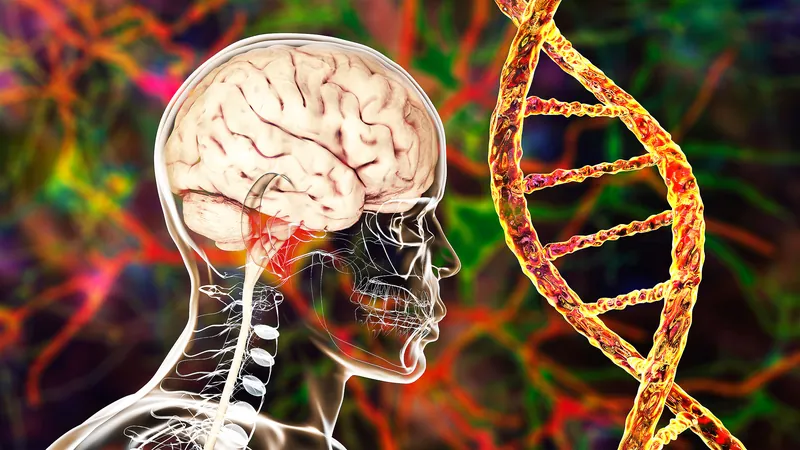
Revolutionary Discovery: Neanderthal DNA Linked to Autism in Modern Humans!
2025-07-07
Author: Charlotte
When we think of Neanderthals, we might picture heavy brows, furry skins, and primitive tools. But what if I told you that their DNA lives on in us today? A groundbreaking study has found that some of the genetic fragments inherited from these ancient hominins could be tied to autism spectrum disorder (ASD).
A Journey Through Time: The Intermingling of Species
Around 50,000 to 60,000 years ago, small bands of modern humans left Africa and ventured into Eurasia, crossing paths with Neanderthals. This wasn't just a chance meeting; they exchanged tools and, crucially, genes through interbreeding. It is estimated that populations with Eurasian roots carry about 2% Neanderthal DNA—left over from early interactions after modern humans migrated.
Genetic Footprints: The Neanderthal Legacy
This ancient DNA has scattered across the globe, with most modern humans containing traces, varying from person to person. While some Neanderthal genes have beneficial effects, bolstering immunity or surviving at high altitudes, others didn’t integrate well with our biology and were phased out through natural selection.
Diving into the DNA: Autism and Neanderthal Genetics
The study, conducted by researchers from Clemson University and Loyola University, compared genetic information from autistic individuals alongside their non-autistic siblings and unrelated controls from diverse backgrounds. The findings were stunning—both rare and common Neanderthal-derived variants were more prevalent in those with autism.
Decoding the Brain Connectivity
One striking observation pointed to how certain genes influence communication between distant brain regions. Results showed that visual-processing areas were highly active in participants, while networks associated with social engagement and daydreaming displayed reduced activity. This pattern reflects traits commonly experienced by many autistic individuals, such as sophisticated pattern recognition coupled with social fatigue.
Unraveling the Mysteries of Ancient Expertise
Functional MRI scans confirmed these exciting insights, showing that individuals with higher Neanderthal genetic loads—whether autistic or not—exhibited intensified activity in visual processing areas, while regions typically active during social interactions were less stimulated. This hints that our primitive predecessors may have cultivated cognitive strengths that still resonate today.
An Evolutionary Advantage?
But why did these Neanderthal traits endure? One theory suggests that in small, close-knit communities, keen observational skills for scouting resources could have outweighed the complexities of social dynamics. When early Homo sapiens interbred with Neanderthals, these perceptual strengths became valuable.
A New Perspective on Autism
Importantly, the research does not claim that Neanderthal DNA causes autism. Instead, it proposes that inherited variations could increase the likelihood of certain traits appearing along the autism spectrum. These traits may have provided advantages in historical environments—and perhaps still do in today’s fields that value logic and precision.
Navigating the Complexities of Neurodiversity
While genetics is a significant part of the autism narrative, it's crucial to acknowledge that environment and early development play equally vital roles. This discovery sheds light on why autism manifests universally, regardless of cultural background, framing neurodiversity as part of humanity’s rich genetic tapestry.
Looking Ahead: The Future of Research
The research team expressed hope that their findings will inspire deeper exploration into the lingering effects of ancient genome mixing on human development, intelligence, and health. Future studies will delve into other neurodevelopmental conditions and examine how Neanderthal variants interact with modern lifestyles, potentially refining personalized support.
The narrative of human evolution is a tale of convergence, intertwining the strengths of different lineages and leaving indelible marks that influence our perception and creative capacities today. The full study was published in "Molecular Psychiatry." Stay tuned for more thrilling scientific discoveries!









 Brasil (PT)
Brasil (PT)
 Canada (EN)
Canada (EN)
 Chile (ES)
Chile (ES)
 Česko (CS)
Česko (CS)
 대한민국 (KO)
대한민국 (KO)
 España (ES)
España (ES)
 France (FR)
France (FR)
 Hong Kong (EN)
Hong Kong (EN)
 Italia (IT)
Italia (IT)
 日本 (JA)
日本 (JA)
 Magyarország (HU)
Magyarország (HU)
 Norge (NO)
Norge (NO)
 Polska (PL)
Polska (PL)
 Schweiz (DE)
Schweiz (DE)
 Singapore (EN)
Singapore (EN)
 Sverige (SV)
Sverige (SV)
 Suomi (FI)
Suomi (FI)
 Türkiye (TR)
Türkiye (TR)
 الإمارات العربية المتحدة (AR)
الإمارات العربية المتحدة (AR)